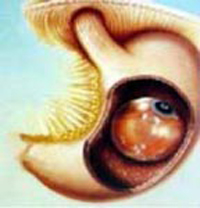Intragastric Balloon
 An intragastric balloon is a device designed to facilitate weight loss in patients with obesity. It is a silicone sphere which, when inserted in the stomach under endoscopic control, is filled with 600 cm3 of water and left to float freely in the gastric cavity. As the balloon partially occupies the stomach and makes stomach emptying more difficult, it reduces the sensation of hunger and makes patients feel full earlier when eating. With these two effects, it is easier to follow a suitable diet and make the necessary diet and exercise changes not only to lose weight but also to maintain this weight loss in the following months.
An intragastric balloon is a device designed to facilitate weight loss in patients with obesity. It is a silicone sphere which, when inserted in the stomach under endoscopic control, is filled with 600 cm3 of water and left to float freely in the gastric cavity. As the balloon partially occupies the stomach and makes stomach emptying more difficult, it reduces the sensation of hunger and makes patients feel full earlier when eating. With these two effects, it is easier to follow a suitable diet and make the necessary diet and exercise changes not only to lose weight but also to maintain this weight loss in the following months.
In what cases can it be used?
Balloon insertion is indicated in obese patients from 18 to 60 years of age, with a body mass index from 30 to 40 kg/m2 (premorbid obesity), normally meaning that they are 15-25 kg overweight. The balloon is exceptionally used in cases of morbid obesity, to reduce surgical risk or in the presence of contraindications for surgery, and in cases of mild excess weight until it is corrected. It cannot be used in patients with endocrine or mental disorders that prevent them from following a diet, together with patients with previous gastric surgery, hiatus hernia or severe clotting disorders.
What are the different phases of the treatment?
The balloon is removed after 6 months. Over the first 2-3 days, nausea, vomiting and epigastric discomfort are normal as the stomach attempts to reject the balloon, but there are usually no further subsequent undesirable effects.
The balloon itself does not cause weight loss; check-ups with a specialist are required, who will indicate and supervise the diet, which is easy to follow without a sensation of hunger, anxiety or the other undesirable effects normally associated to weight loss diets.
Centro Médico Teknon, long and qualified expertise with intragastric balloons
To receive this treatment, it is important to contact the best specialists with experience who form part of multidisciplinary teams. It is an endoscopic technique and should only be performed by an expert endoscopist in an Endoscopy Unit such as the one at Centro Médico Teknon, the first to introduce the intragastric balloon in Spain. Since then, we have helped to improve the insertion and removal techniques, and designed a follow-up protocol for the first 24-72 hours that has led us to become one of the centres with the lowest balloon rejection rate (2%). In the last balloons we have removed, our average weight loss was around 20-22 kg.
This type of operation can be delicate, especially in high risk patients. It is therefore important that it is performed by qualified and experienced professionals in facilities adapted and prepared for this type of surgery. Choosing a first-class clinic guarantees the success of the operation and minimises possible associated risks, such as haemorrhage, infections, pulmonary embolism or suture failures, which occur in 3-5% of all cases.



















